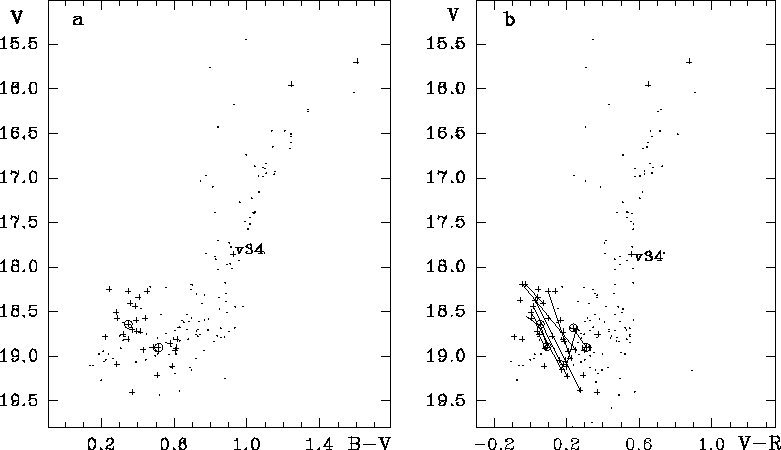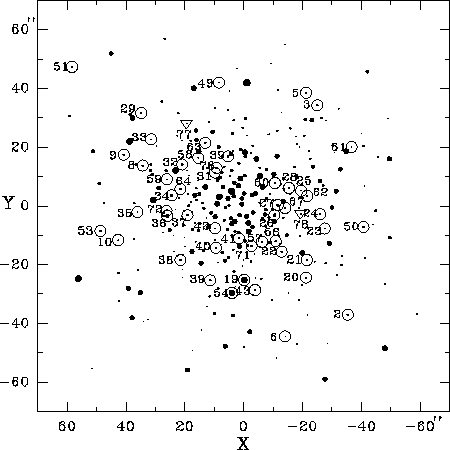|
Peremennye Zvezdy (Variable Stars) 26, No. 1, 2006 Received 2006 January 10; accepted 2006 January 21. |
Article in PDF |
Variable stars in the globular cluster NGC 7006
A.N. Gerashchenko
The Main Astronomical Observatory (Pulkovo) of Russian
Academy of Sciences,
65/1, Pulkovo Highway, St.-Petersburg
196140, Russia,
e-mail: ger@gao.spb.ru
| Our BVR CCD photometric study of the globular cluster NGC 7006 permitted us to find two new suspected RR Lyrae variables. A cluster chart is presented with the position of known and suspected variables marked. |
The globular cluster NGC 7006 (C 2059+160,
![]() ,
,
![]() ) is highly interesting from many points of view, in
particular, for its richness in variable stars. According to the
Catalogue of Variable Stars in Globular Clusters (Clement et al.,
2001), it contains 76 variables, most of which are RR Lyrae
variables, the RR1 to RR0 ratio being 8:55. This ratio, together
with the average period
) is highly interesting from many points of view, in
particular, for its richness in variable stars. According to the
Catalogue of Variable Stars in Globular Clusters (Clement et al.,
2001), it contains 76 variables, most of which are RR Lyrae
variables, the RR1 to RR0 ratio being 8:55. This ratio, together
with the average period
![]() (Wehlau et al.,
1999), permits us to refer to the cluster as an Oosterhoff type
Oo I object abundant with RR Lyrae variables. Therefore, a search
for undetected variables of this type is of interest.
(Wehlau et al.,
1999), permits us to refer to the cluster as an Oosterhoff type
Oo I object abundant with RR Lyrae variables. Therefore, a search
for undetected variables of this type is of interest.
In the Catalogue (Clement et al., 2001), data for two pairs of variables with practically the same coordinates are given without any comments. The stars of the first pair (v34 and v59) have different positions in the cluster chart (cf., for instance, Wehlau et al., 1999), and the chart position of v34 does not agree with its coordinates (the correct coordinates are given in the Table below). In the Catalogue (Clement et al., 2001), this star is marked as ``prob not var'', and as shown below (Fig. 1), it cannot be either an RR Lyrae star or a red variable according to our photometric data.
Another pair of variables (v41 and v74) deserve a more detailed consideration. In the study of variables in the globular cluster NGC 7006, Rosino and Ciatti (RC, 1967) determined periods for the majority of the known variables, v1 - v52 (among them, v41 was not present), and found twenty-one new variables. The position of v74, one of these new variables, given in their chart is the same as the position of v41 in the Sandage (1954) chart. Later Pinto and Rosino (1973) determined periods for all the variables that had not been determined by RC (1967), and they gave different periods for v41 and v74. Therefore the question arises: what are the two stars (v41 and v74) with different periods that Pinto and Rosino (1973) observed? According to Wehlau et al. (1992), L. Rosino explained, in a private communication, that v74 was a rediscovery of v41.
Our search for variables is based on CCD observations carried out
in 1995 with the Zeiss-1000 telescope of the Special Astrophysical
Observatory (Russia). Wide-band filters and the K585 detector
provided the ![]() Johnson-Cousins photometric system. The whole
chip (
Johnson-Cousins photometric system. The whole
chip (![]() pixels) covers a field of
pixels) covers a field of
![]() on the sky, the
scale is
on the sky, the
scale is
![]() /mm. After the CCD frames had been
bias-subtracted and flat-field-corrected, photometry was carried
out using the ESO-Midas package. Reductions of the instrumental
magnitudes to the standard
/mm. After the CCD frames had been
bias-subtracted and flat-field-corrected, photometry was carried
out using the ESO-Midas package. Reductions of the instrumental
magnitudes to the standard ![]() system made use of the CCD
photometric standards (Odelwahn et al., 1992) located in the
investigated cluster field. Exposure times in the
system made use of the CCD
photometric standards (Odelwahn et al., 1992) located in the
investigated cluster field. Exposure times in the ![]() ,
, ![]() , and
, and
![]() bands were respectively 600, 300 and 180 seconds, and a
maximum time interval between consecutive exposures in the
bands were respectively 600, 300 and 180 seconds, and a
maximum time interval between consecutive exposures in the ![]() ,
,
![]() and
and ![]() ,
, ![]() bands did not exceed 15 minutes. In such a case,
the
bands did not exceed 15 minutes. In such a case,
the ![]() ,
, ![]() and
and ![]() ,
, ![]() magnitudes of a variable correspond to
the same phase of its variability. Although the cluster is
relatively not dense (
magnitudes of a variable correspond to
the same phase of its variability. Although the cluster is
relatively not dense (
![]() , Webbink 1985),
reliable photometry could be obtained for stars with
, Webbink 1985),
reliable photometry could be obtained for stars with
![]() .
.
In order to search for as yet undetected variables, the method
proposed by Kadla and Gerashchenko (1982) was used. For this
purpose, color-magnitude diagrams (CMD's) (![]() and
and ![]() ) were plotted (Fig. 1) using variables' magnitudes
obtained from two consecutive
) were plotted (Fig. 1) using variables' magnitudes
obtained from two consecutive ![]() ,
, ![]() and
and ![]() ,
, ![]() exposures and
the mean magnitudes from 3
exposures and
the mean magnitudes from 3 ![]() , 5
, 5 ![]() , and 4
, and 4 ![]() exposures for
other stars.
exposures for
other stars.
 |
| Figure 1.
CMD's (a: |
for suspected and some of known variable stars.
| No. | X | Y | ΔV | ΔR |
| 77 | 19
|
27
|
0 |
0 |
| 78 | -19.31 | -2.76 | 0.25 | 0.5 |
| 34 | 24.42 | 3.50 | 0.0 | 0.0 |
| 49 | 8.62 | 41.85 | 0.4 | 0.5 |
| 76 | 9.16 | 12.83 | 0.5 | 0.7 |
All known RR Lyrae variables occupy a definite strip on both
CMD's, except v34, which is at the middle part of the giant branch
and whose variability was questioned. For some variables, there
are observations at two different phases of their variability in
the ![]() and
and ![]() photometric bands. Such variables are shown in
Fig. 1(b) as two pluses or two
photometric bands. Such variables are shown in
Fig. 1(b) as two pluses or two ![]() signs, corresponding to
two phases of variability, connected with a line. Other stars
located within the strip on both diagrams were investigated for
variability. Two of such stars demonstrate brightness variations
in the
signs, corresponding to
two phases of variability, connected with a line. Other stars
located within the strip on both diagrams were investigated for
variability. Two of such stars demonstrate brightness variations
in the ![]() band and especially in the
band and especially in the ![]() band, where observations
span a longer time. Data on these suspected RR Lyrae variables
are given in the Table. It contains the star number (continuing
numbering the variable stars in the Clement et al. 2001
catalogue), coordinates expressed in arcseconds and determined in
the coordinate system of the Catalogue (Clement et al., 2001),
brightness variations of the star in the
band, where observations
span a longer time. Data on these suspected RR Lyrae variables
are given in the Table. It contains the star number (continuing
numbering the variable stars in the Clement et al. 2001
catalogue), coordinates expressed in arcseconds and determined in
the coordinate system of the Catalogue (Clement et al., 2001),
brightness variations of the star in the ![]() and
and ![]() bands. Also
we give coordinates of known variables (v49 and v76) which were
inaccurate or completely absent in the Clement et al. (2001)
catalogue. All variables (known and suspected) are marked in the
cluster chart (Fig. 2).
bands. Also
we give coordinates of known variables (v49 and v76) which were
inaccurate or completely absent in the Clement et al. (2001)
catalogue. All variables (known and suspected) are marked in the
cluster chart (Fig. 2).
 |
| Figure 2. Identification chart for most of the variable stars in the central part of the globular cluster NGC 7006. Known variables are circled, with their identifying numbers placed, if possible, to the left of the star's image; the suspected ones are plotted as triangles, with their identifying numbers placed below the star's image. |
References:
Clement, C., Muzzin, A., Dufton, Q. et al, 2001, Astron. J., 122, 2587.
Kadla, Z., Gerashchenko, A.N., 1982, Pulkovo Izvestia (Glavnaia Atsronomicheskaia Observatoriia), No. 199, 86.
Odelwahn, S.C., Bryja, C., Humphreys, R.M., 1992, Publ. Astron. Soc. Pacific, 104, 553.
Pinto, G., Rosino, L., 1973, Mem. Soc. Astron. Italiana, 44, 255.
Rosino, L., Ciatti, F., 1967, Contrib. Oss. Astrofis. Asiago, No. 199.
Sandage, A., 1954, Publ. Astron. Soc. Pacific, 66, 324.
Webbink, R. F., 1985, in Dynamics of Star Clusters, IAU Symposium 113, Goodman J., Hut P., (eds.), Reidel, Dordrecht, p. 541.
Wehlau, A., Nemec, J.M., Hanlan, P., Rich, R.M., 1992, Astron. J., 103, 1583.
Wehlau, A., Slawson, R.W., Nemec, J.M., 1999, Astron. J., 117, 286.